Push Notifications
This guide walks you through setting up the Rover SDK in your app to enable push notifications.
Enable Notifications
The first step is to add the Push Notifications feature to your App ID and the Push Notifications entitlement to your app. This is done from within Xcode. Open your Xcode project or workspace and select your app from the Project navigator. Then select your app’s target and the “Capabilities” tab.
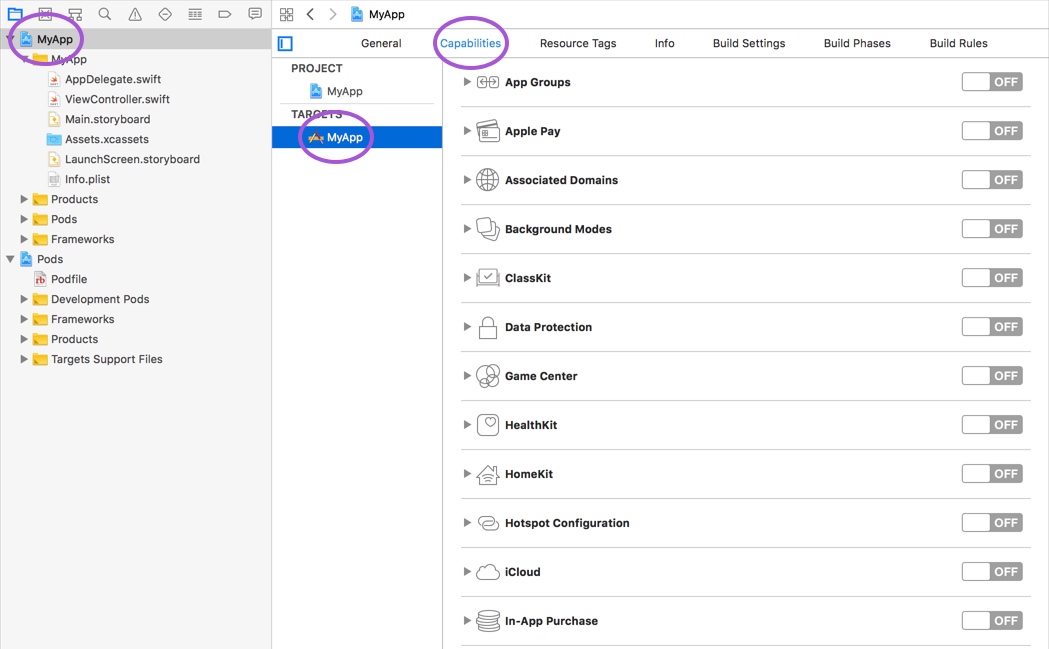
Scroll down to the bottom of the list. Find the Push Notifications capability and enable it. After a brief wait, you should see two confirmation checkmarks.
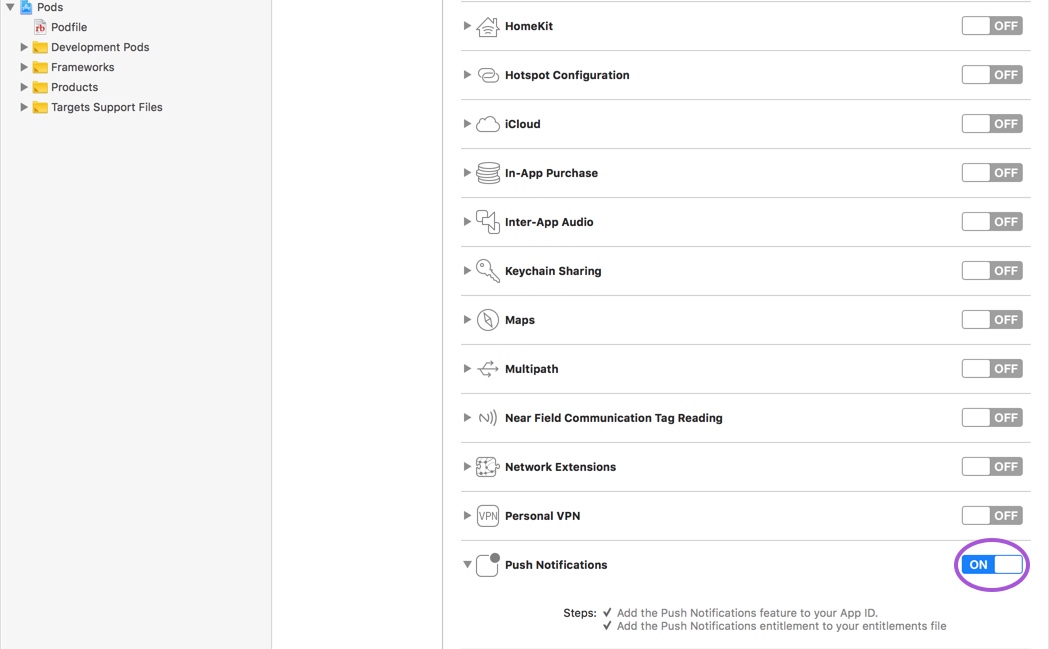
Device Token
Before a user of your app can receive remote notifications, the device must register itself with the Apple Push Notification Service (APNS). After successful registration, a unique token is returned that can be used to identify the device to APNS. Rover uses this token to send remote notifications to your users through your app. In order to enable this functionality you must perform the steps necessary to register each device with APNS and pass the resulting token to the Rover SDK.
Register with APNS
The first step is to initiate the APNS registration process by calling the registerForRemoteNotifications() method on the application object from within your app delegate’s application(_:didFinishLaunchingWithOptions:) method.
func application(_ application: UIApplication, didFinishLaunchingWithOptions launchOptions: [UIApplication.LaunchOptionsKey: Any]?) -> Bool {
// ...
// Register to receive remote notifications via Apple Push Notification service.
application.registerForRemoteNotifications()
return true
}
Capture the Token
After succesfully registering with APNS your app delegate’s application(_:didRegisterForRemoteNotificationsWithDeviceToken:) method will be called. The value of the deviceToken parameter is the token Rover needs to be able to send remote notifications to the device. To pass the token to the Rover SDK, resolve an instance of TokenManager and call its setToken(_:) method.
func application(_ application: UIApplication, didRegisterForRemoteNotificationsWithDeviceToken deviceToken: Data) {
Rover.shared!.resolve(TokenManager.self)?.setToken(deviceToken)
}
💥 Crash Early
The above sample code intentionally force unwraps the Rover.shared singleton. It is imperative that Rover has been initialized before the application(_:didRegisterForRemoteNotificationsWithDeviceToken:) method is called otherwise you will have missed the opportunity the capture the device’s token.
If you have taken the recommended approach of initializing the Rover SDK in your application(_:didFinishLaunchingWithOptions:) method then the Rover.shared singleton will always be initialized before the application(_:didRegisterForRemoteNotificationsWithDeviceToken:) method is called. If Rover.shared is nil at this point then something has gone wrong. We recommend adopting the “crash early” approach by force-unwrapping the Rover.shared singleton to identify problems as soon as possible.
See the Installation and Initialization guide for more information on initialization.
Requesting Authorization
After enabling notifications and capturing the device token, everything is in place for Rover to deliver remote notifications to your app. However, before your application can display an alert, badge your app’s icon, or play a sound, it must request authorization from the user.
Request Authorization at Launch Time
The simplest approach is to request authorization in your app delegate’s application(_:didFinishLaunchingWithOptions:) method. Get the shared UNUserNotificationCenter object and call its requestAuthorization(options:completionHandler:) method.
import UserNotifications
let center = UNUserNotificationCenter.current()
// Request permission to display alerts, badge your app's icon and play sounds.
center.requestAuthorization(options: [.alert, .badge, .sound]) { (granted, error) in
}
The first time your app makes this authorization request, the operating system will prompt the user for permission to display notifications. The user’s response is saved and subsequent requests will not prompt the user again. This simplifies your code as you do not have to check first to see if the user has already given permission before making this call. In other words, there is no negative consequence to calling this method every time your app launches.
Deferring Authorization
As mentioned, the operating system saves the user’s response to an authorization request and subsequent requests will not prompt the user again. While this simplifies your code, it also means you only have one attempt at getting permission from your user.
A common pattern when launching an app for the first time is to go through an “onboarding experience” and many apps integrate the notification authorization process into the onboarding. A best-practice has emerged where the user is presented with a screen explaining the benefits of authorizing notifications before the request has been made. This “pre-auth” screen usually asks the user if they would like to receive notifications and presents the user with two buttons: “Yes” and “Maybe later”. The notification request is only made if user taps the “Yes” button. If they tap “Maybe later” the onboarding process continues without requesting authorization, giving your app the opportunity to ask again at another time.
Handling Notifications
For your application to respond when a user taps a notification, or to process notifications that arrive when your app is running in the foreground, you assign a delegate object to the shared UNUserNotificationCenter. This must be done before your app finishes launching or you might miss incoming notifications. The most common approach is to use your existing app delegate.
Assign your App Delegate
First, extend your app delegate to conform to UNUserNotificationCenterDelegate.
import UserNotifications
extension AppDelegate: UNUserNotificationCenterDelegate {
// ...
}
Next assign your app as the delegate for the shared UNUserNotificationCenter from within your application(_:didFinishLaunchingWithOptions:) method.
func application(_ application: UIApplication, didFinishLaunchingWithOptions launchOptions: [UIApplication.LaunchOptionsKey: Any]?) -> Bool {
// ...
UNUserNotificationCenter.current().delegate = self
return true
}
Responding to Taps
Notifications sent from Rover have an expected action to be taken when the user taps the notification. For example a notification might launch a Rover Experience when it is tapped, or present a website. The desired behavior is defined in the Campaigns app by the user who authors the notification campaign.
In order to execute the expected behavior you must implement the userNotificationCenter(_:didReceive:withCompletionHandler:) method in your UNUserNotificationCenter delegate and ask Rover to handle the notification.
func userNotificationCenter(_ center: UNUserNotificationCenter, didReceive response: UNNotificationResponse, withCompletionHandler completionHandler: @escaping () -> Void) {
// Resolve the NotificationHandler and execute the intended behavior
Rover.shared?.resolve(NotificationHandler.self)?.handle(response, completionHandler: completionHandler)
}
The NotificationHandler service in the above code sample inspects the payload of the notification to determine the intended behavior and executes it.
Foreground Notifications
If a notification is received when your app is in the foreground, the default behavior on iOS is to ignore it. To opt-in to displaying notifications when your app is in the foreground, implement the userNotificationCenter(_:willPresent:withCompletionHandler:) method in your UNUserNotificationCenter delegate and call the completionHandler.
func userNotificationCenter(_ center: UNUserNotificationCenter, willPresent notification: UNNotification, withCompletionHandler completionHandler: @escaping (UNNotificationPresentationOptions) -> Void) {
// Treat this notification the same as if the app was in the background
completionHandler([.badge, .sound, .alert])
}
Notification Extension
The Rover SDK relies on a UNNotificationServiceExtension for two features:
- Adding rich media (images, videos and audio clips) to notifications.
- Tracking “influenced opens”.
If you wish to take advantage of either of these features you will need to add UNNotificationServiceExtension to your app.
Select your project in the Xcode Project navigator then click the plus (+) icon at the bottom of the target list to add a new target.

In the resulting modal type “service” into the search field to select the Notification Service Extension and then click Next.
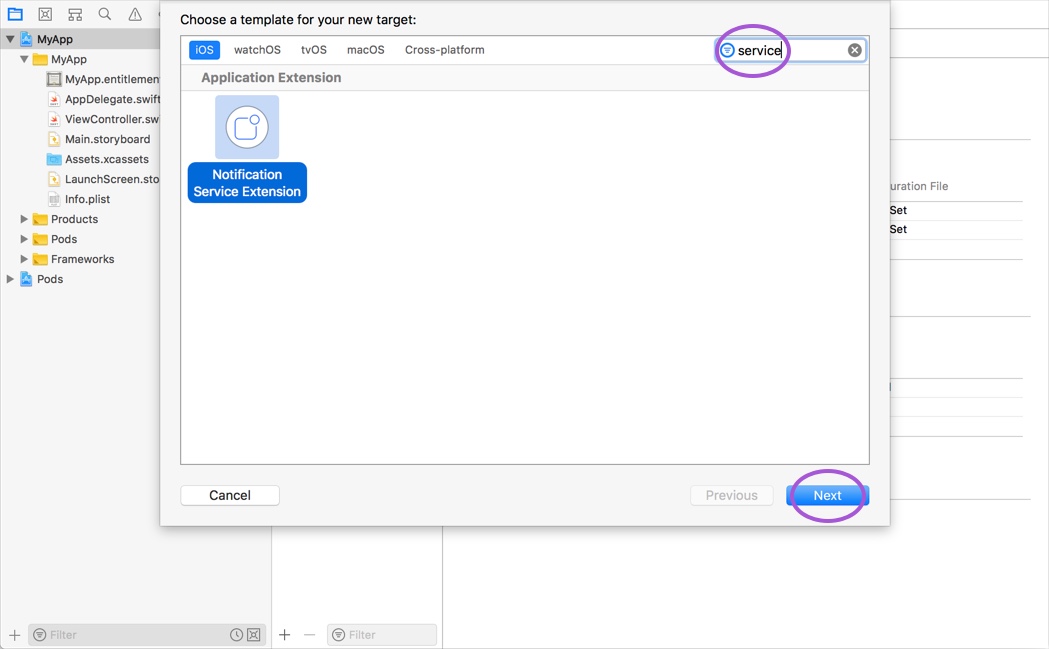
Name the new target NotificationService and click “Finish”.
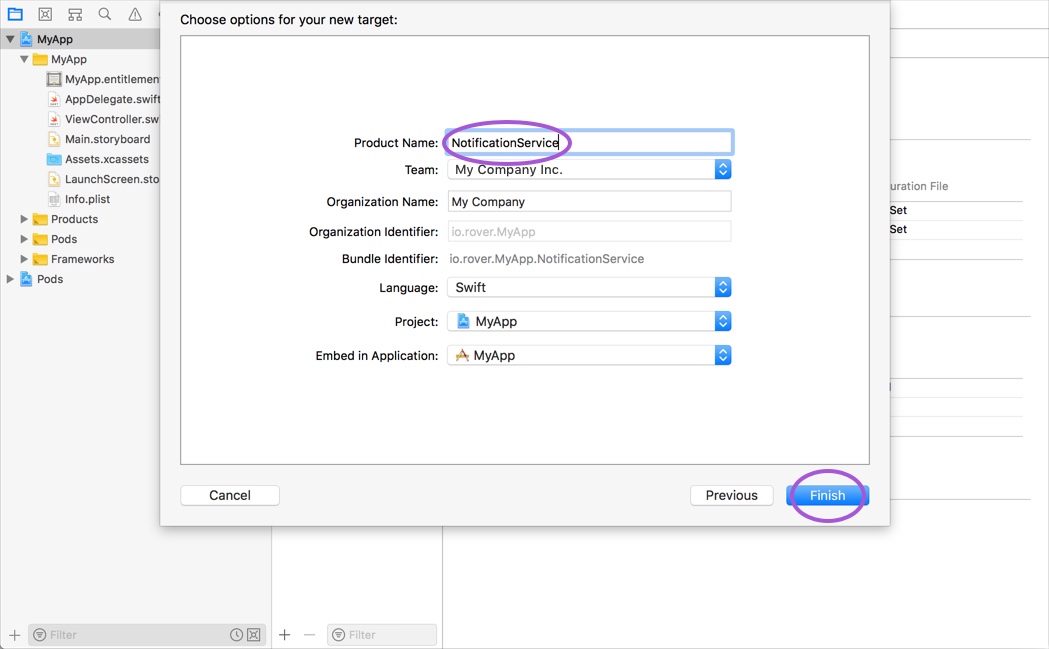
If you see a prompt asking you to activate the scheme click Cancel. This ensures Xcode will continue debugging your app instead of just the notification service extension.
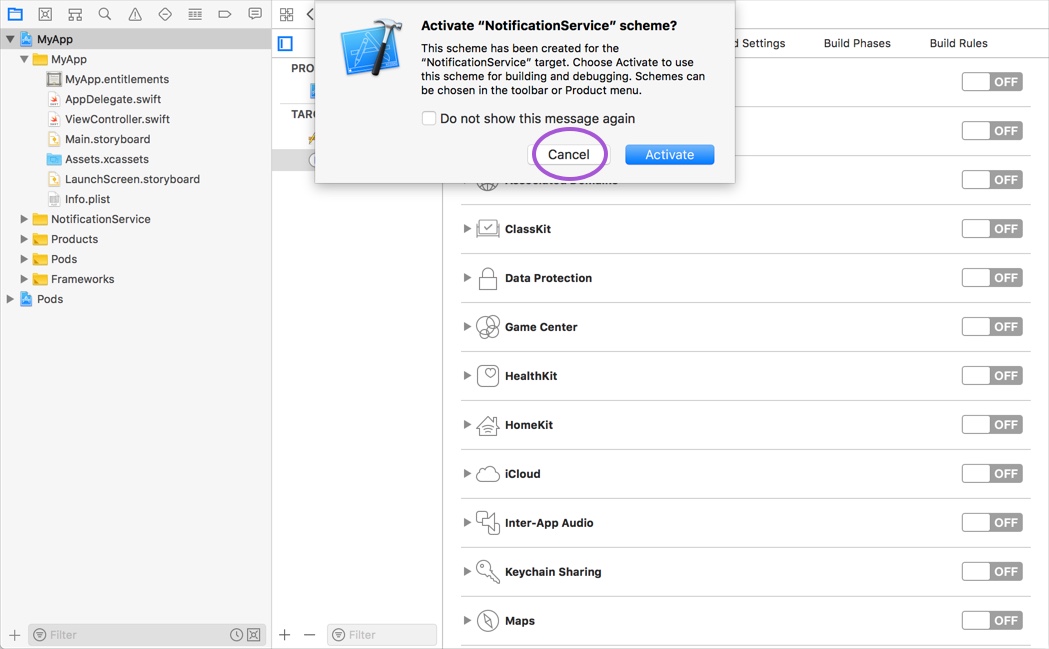
Select your app target (not your extension) from the list of targets, choose the Capabilities tab and turn on App Groups.
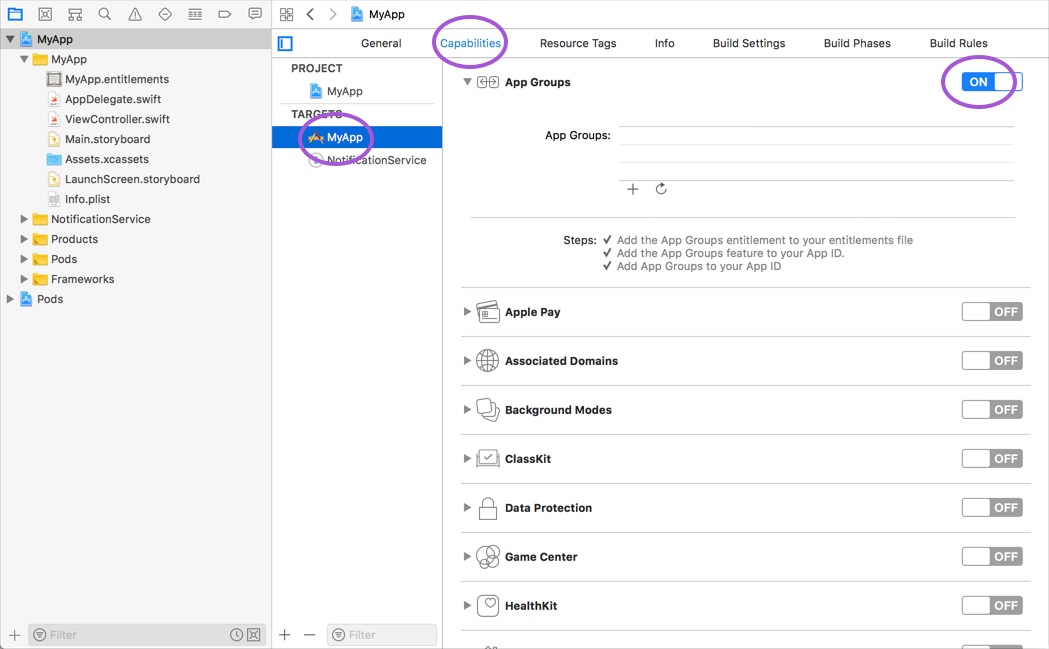
Name your app group by prepending “group.” to your bundle identifier. E.g. “group.com.example.My-App.
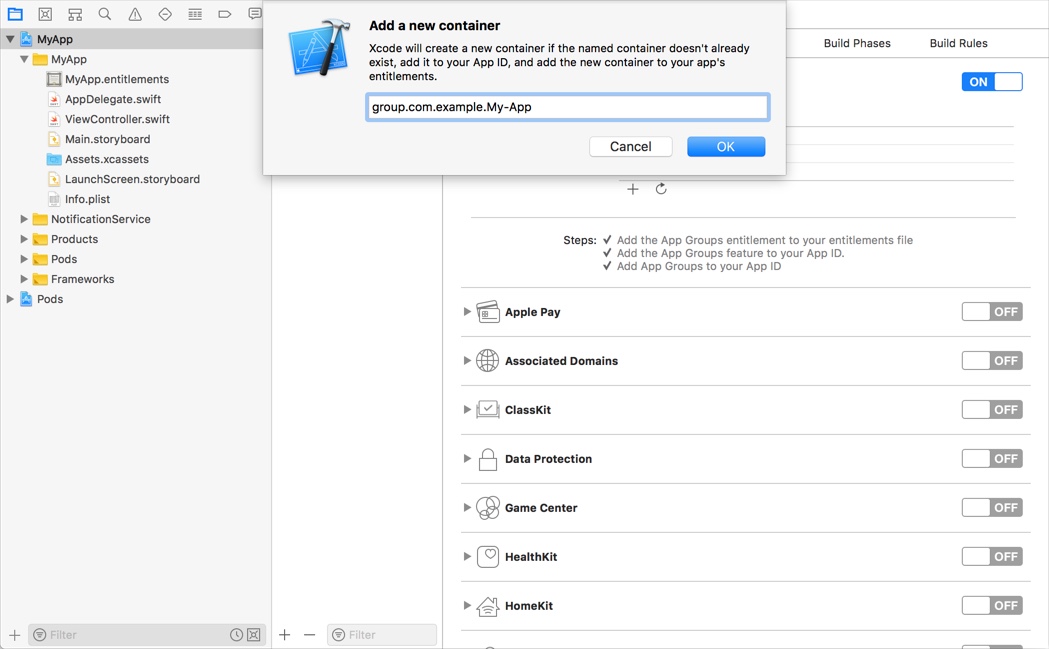
Finally select your extension target in the list of targets. You should see the same group you added to your app in the list of available App Groups. You may need to click the refresh icon for it to show up. Enable the app group for your extension.
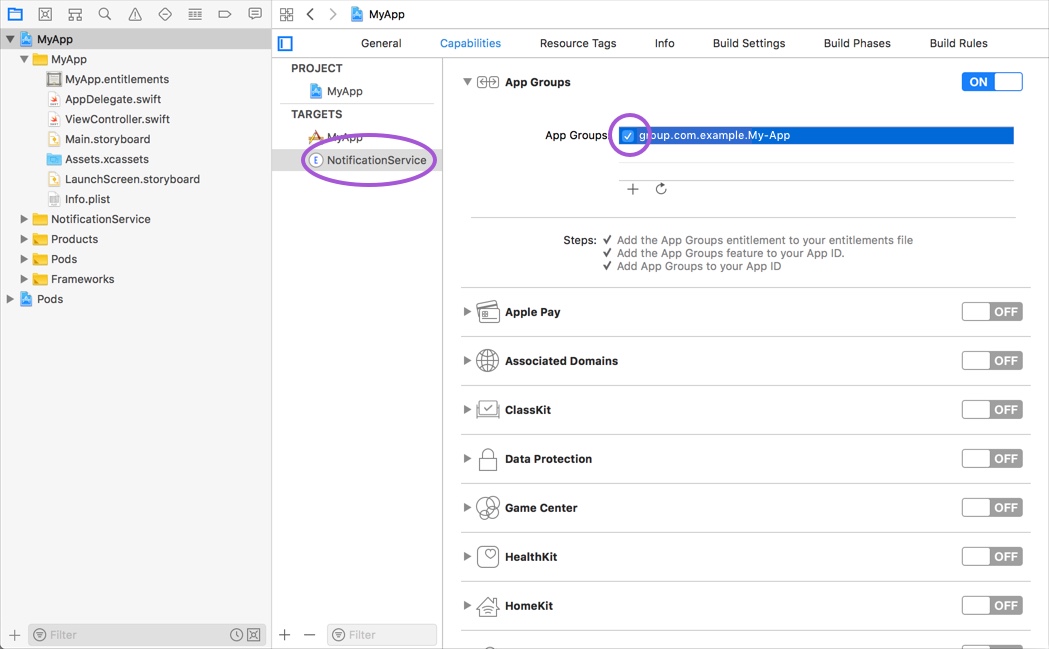
RoverAppExtensions
In addition to the main Rover SDK there is a separate framework called RoverAppExtensions. This framework contains only the app extension API and is therefore safe to use in your newly create extension.
If you are using Cocoapods you will need to add a new entry to your Podfile:
target 'NotificationService' do
use_frameworks!
pod 'RoverAppExtensions', '~> 2.3.0'
end
Then run pod install from your project directory.
If you are using Carthage, look in your Carthage/Build folder and add the RoverAppExtensions and the RoverFoundation frameworks to your NotificationService target.
NotificationExtensionHelper
When you created the new service target Xcode created a corresponding class named NotificationService with a sample implementation. Open the class and import RoverAppExtensions.
import RoverAppExtensions
Then replace the implementation of didReceive(_:withContentHandler:) method with the following, substituting YOUR_APP_GROUP with the name of your actual app group:
override func didReceive(_ request: UNNotificationRequest, withContentHandler contentHandler: @escaping (UNNotificationContent) -> Void) {
self.contentHandler = contentHandler
bestAttemptContent = (request.content.mutableCopy() as? UNMutableNotificationContent)
if let bestAttemptContent = bestAttemptContent {
NotificationExtensionHelper(appGroup: "YOUR_APP_GROUP")?.didReceive(request, withContent: bestAttemptContent)
contentHandler(bestAttemptContent)
}
}
The last step is to update your Rover initialization code to pass the NotificationAssembler the name of the app group you just created.
Rover.initialize(assemblers: [
// ...
NotificationsAssembler(appGroup: "group.io.rover.inbox")
])
Required Modules
- RoverFoundation
- RoverData
- RoverUI
- RoverNotifications